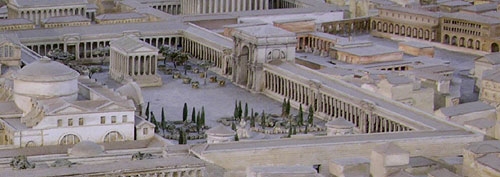
On election days during the Republic, this open rectangular space was divided by ropes into as many compartments as there were electoral sections: thirty (30) for the comitia curiata, thirty five (35) for the comitia tributa, and eighty (80) for the comitia centuriata. On one of the long sides of the courtyard and opposite the entrance, there was a platform (pons or bridge) with as many wooden steps as electoral bodies (see this Republican coin depicting a voting scene; the pons is clearly shown, as is the voter depositing his voting tablet in an urn). A rogator sat on each step handing the tablets to the voters as they walked past him one by one; they then deposited their voting tablets in the urn. In the middle of the platform, stood the official presiding over the elections, who made sure that they were conducted properly. (Mommsen, Staatsrecht iii.399-402)
The Romans used to hold their military and popular assemblies in the large courtyard of the Saepta until the time of Tiberius. After Tiberius, who transferred the elections from the people to the senate, the Saepta became mainly an art and antiquities market. Also, in the time of the empire, gladiatorial combats and even naval battles were staged by Augustus and other emperors. These shows took place in the west side of the porticus in an open area, while the spectators watched them from the roof or the upper story of the Saepta as well as from platforms erected in the arcades. To catch a glimpse of the games click here.
You see a series of inscriptions with instructions on elections (dies comitialis) as these were conducted during the Republic. If you are a voter (suffragator), please read them carefully by clicking on each.